Full Custom Design of an Inverter using IC Station and the AMI Rules
INTRODUCTION
In this tutorial you will learn how to use Mentor Graphics ICStation
to construct a mask level layout of an inverter. You will manually create
the artwork which specifies transistor layouts and their interconnection.
You will also verify that there are no design rule errors in the final
layout. You will translate a static CMOS inverter onto an NWELL and PWELL
process using AMI's 0.5 micron technology.
1. Start IC Station and Open a new cell
1.1 Create a directory for this lab and move into it. Open
IC Station:
>> cd egre429
>> mkdir lab2
>> cd lab2
>> adk_ic &
1.2 In the session palette window, click on CREATE with LMB (left
mouse button). In the Create Cell dialog box that comes up, set
the cell name to my_inv and the cell type to block. Click
on the Navigator... button under the Process item and navigate
to the $ADK/technology/ic/ami05 process file and click OK.
Click on the Navigator... button under the Rules File item
and select the ami05.rules file and click
OK. The resulting
dialog box should look like the one below:
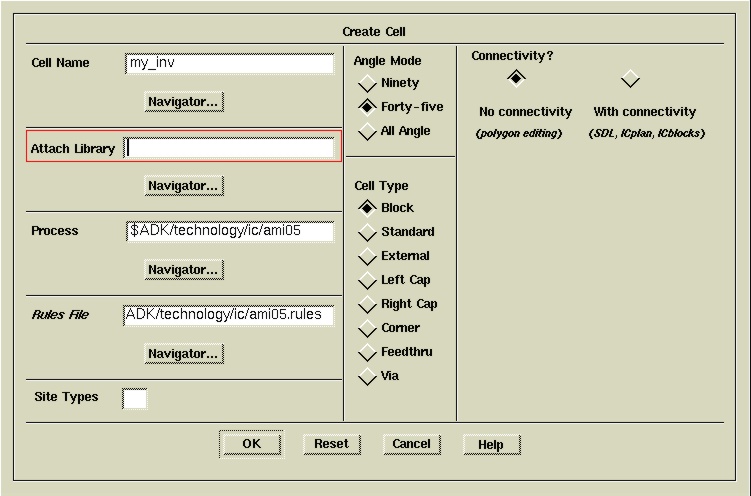
Click the OK button in the Create Cell dialog box and new window
should open with the message Cell "/students/.../egre429/lab2/my_inv"
reserved for edit. Note that in ICStation,
before you can edit a cell, it MUST be reserved for edit. If you close
a cell and reopen it, or save a cell, it is no longer reserved for edit.
You must use the File->Cell->Reserve
menu item to reserve the cell for edit after it has been closed or saved.
2. Layout polygons for the transistors of the inverter
2.1 You will need to draw, modify polygons etc., so click (LMB) on
Easy
Edit in the IC Palette. It will change to that shown on the right.
To create an n-channel device we need POLY over ndiff
. The drawing steps are as follows.

(a) Construct an ACTIVE polygon.
(b) Surround the ACTIVE with N_PLUS_SELECT. The intersection
of the two gives ndiff.
(c) Create a POLY over ndiff and extends beyond the active
area. This results in the gate.
(d) Surround the whole thing with P_WELL.
For a p-channel MOSFET, we need an N_WELL as well. The steps
are as follows:
(a) Construct an ACTIVE polygon.
(b) Surround the ACTIVE with P_PLUS_SELECT. The intersection
of the two gives pdiff.
(c) Create a POLY over ndiff and extends beyond the active area.
This results in the gate.
(d) Surround the whole structure with N_WELL.
Before you start, notice that at the top of the ICStation
window, under the menus, is another bar with the word Cursor: in
it followed by two numbers. These numbers are the current position of the
cursor in lambda coordinates. They are relative to an origin that is fixed
in the window where you will draw your inverter. The coordinates given
below for drawing the inverter refer to these numbers. NOTE: when you place
the cursor in the window and click to start editing, the cursor will sometimes
place a mark in the drawing (a large cross) and the label at the top of
the window will change to To Mark: . In this case, the numbers now
refer to the coordinates relative to the mark placed in the drawing. You
can hit
<Control K> on the key board to switch the numbers back
to absolute coordinates.
2.2 Click on Shape* under Add Objects in the palette window
with LMB. Click on the Options in the prompt bar which appears at
the bottom left hand corner. Choose N_PLUS_SELECT.
2.3 Hit <Control K> to change back from To Mark: to
Cursor:
and press the LMB at -2,-9 and drag it to 16,11 and release. Use the Zoom->
Out... menu item twice to zoom out. Use the popup menu for Edit->
Copy and place the copy at -2, 34. Press F2 to unselect all.
Be sure to click Cancel in the prompt bar to get rid of it after
you are finished with that particular operation!
2.4 Use the pop-up menu, Select-> Edge, choose the top edge of
the top rectangle. Click on the Rel Move item in the Easy Edit
palette . In the prompt bar enter the following (use tab key).
X Offset = 0; Y Offset = 2 & click OK. The top edge should
move up by 2 units.
2.5 We need a PMOS and an NMOS, hence we need to change the top layer.
2.6 Select the top N_PLUS_SELECT, use the pull-down menu Object->Change->Layer,
select
P_Plus_Select, click OK.
2.7 Now we will add the N_WELL. Select the P_PLUS_SELECT, use
the pulldown menu: Edit->Resize.
In the dialog box enter, (use the tab key).
From Layer=P_PLUS_SELECT; To Layer= N_WELL;Resize by =4 hit enter.
A green rectangle representing N_WELL will appear.
2.8 Unselect all and select the N_PLUS_SELECT layer. Add a P_WELL
4 units away as you did above for the N_WELL.
2.9 You have laid the ground work, let us make the transistors. From
the palette menu, Add->Shape , choose ACTIVE and draw a rectangle
from 0,-7 to 14, 9 and from 0,36 to 14,54.
2.10 Now add the gate Click on Path (Under Add Objects), click
on Options, choose POLY and enter 2 for width in the dialog
box that comes up. Place the cursor at 7,56 and single click with the LMB,
go all the way to 7,-9 and double click. Hit F2 to unselect all.
2.11 Hit Shift F8 to view all. Draw a counter clockwise
circle with the MMB (middle mouse button) around the lower set of rectangles
to zoom in. Choose
Add->Shape, click on options and choose CONTACT_TO_ACTIVE.
Draw a 2x2 rectangle at location 2,-4.
2.12 Click with the LMB inside the contact and hit Rel Copy
in the palette, or use the pull-down menu, Edit->Copy->Relative,
in
the prompt bar enter:
Number = 1; X Offset = 0; Y Offset = 8, hit return.
2.12 Using this mechanism, or simply by selecting the contact and hitting
Copy
and placing the copy manually, place a copy of the contacts at locations
2,50 2,44 2,38 10,50 10,44 10,38 10,-4 and 10,4. Hit F8 to view all and
unselect all by drawing a U with MMB.
2.13 To add power rails, choose METAL1 and draw a rectangle (a
shape) starting at -6,-23 and ending at 20,-13. Hit F2 to unselect
all.
2.14 Use Select->Area
to select the METAL1 and copy it at -6,60. Unselect all.
2.15 Use Select->Edge
to move the top edge of the N_WELL to y = 70. Hit F2. Use
Select->Edge
again to move the bottom edge of the P_WELL to y = -23. Hit F2.
Your
layout should look like the one shown below.
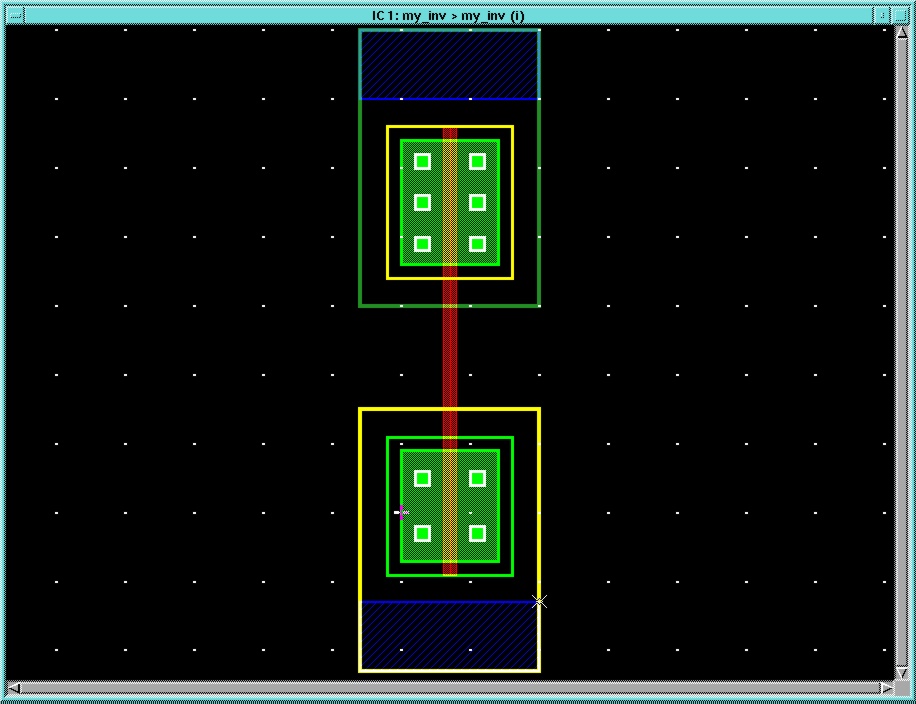
2.16 Let us do quick DRC check of the structure that we have completed
so far. In the Easy Edit palette, click on Back. In the
IC
Palettes palette, click on ICrules. In the ensuing ICrules
palette, click on Check. Click OK in the prompt bar.
You should get a total of 12 errors.
2.17 Under Set Scan to in the ICrules palette, click on
First. At the bottom of your screen, it will come back with a message,
"[Current DRC] Result 1 of 10 in RuleCheck bad_contact_active: Contact
to active must consist of active, CONTACT_TO_ACTIVE, and METAL1 (from:
Ic/drc/drc_results_database 91)". At the same time, the specific contact
in the window will flash.
Click on next, and you will see errors for all of the contacts.
Finally, you will get two errors for contact in the P_WELL and N_WELL
" [Current DRC] Result 1 of 1 in RuleCheck bad_nwell: Nwell must
have well contact (from: Ic/drc/drc_results_database 91)"
"[Current DRC] Result 1 of 1 in RuleCheck bad_psubstrate: Psubstrate
must have a substrate contact (from: Ic/drc/drc_results_database 91)"
These errors will be fixed in the next section. Note that it is good
to perform frequent DRC checks during the design of your circuits. That
way, you avoid having to make extensive changes as a result of not having
enough room to move things around to eliminate a design rule violation!
THE LAYOUT OF THE TRANSISTORS IS COMPLETE, YOU NOW NEED TO "WIRE" IT.
3. Wire the devices to form the inverter
3.1 Go back to the Easy Edit palette. Choose Add->Path,
select METAL1 with a width of 4 and connect the top left contacts
to VDD (3,37 --> 3,60) and the bottom left contacts to GND
(3,7 --> 3,-13). Also connect the right set of contacts together with METAL1,
width 4 (11,-5 --> 11,53). You will need to use <Control K>.
3.2 Use the pop-up menu and Select->All.
Use the pull-down menu, Edit->Flatten.
Click OK in the prompt bar. This will change all the selected paths
into shapes. (Shapes are sometimes easier to deal with because you can
select and move one of their edges at a time).
4. Add input and output ports for the inverter
4.1 Zoom in around the area between the two transistors using O or
Z stroke.
4.2 Use, Add->Shape,
choose METAL1 from the tiny palette, make a rectangle from -4,28
--> 0,20 and 13,24 --> 18,20.
4.3 Use, Add->Shape,
choose POLY and create a shape from -5,23 --> 6,29. Add a 2x2 CONTACT_TO_POLY
at -3, 25 to connect METAL1 and POLY.
4.4. Use, Add->Shape,
choose METAL2 from the tiny palette, make a rectangle from -4,20
--> 0,24 and 14,20 --> 18,24.
4.5 Add a 2x2 VIA at -3,21 and 15,21 to connect metal one to
metal two. Your layout should look like this:
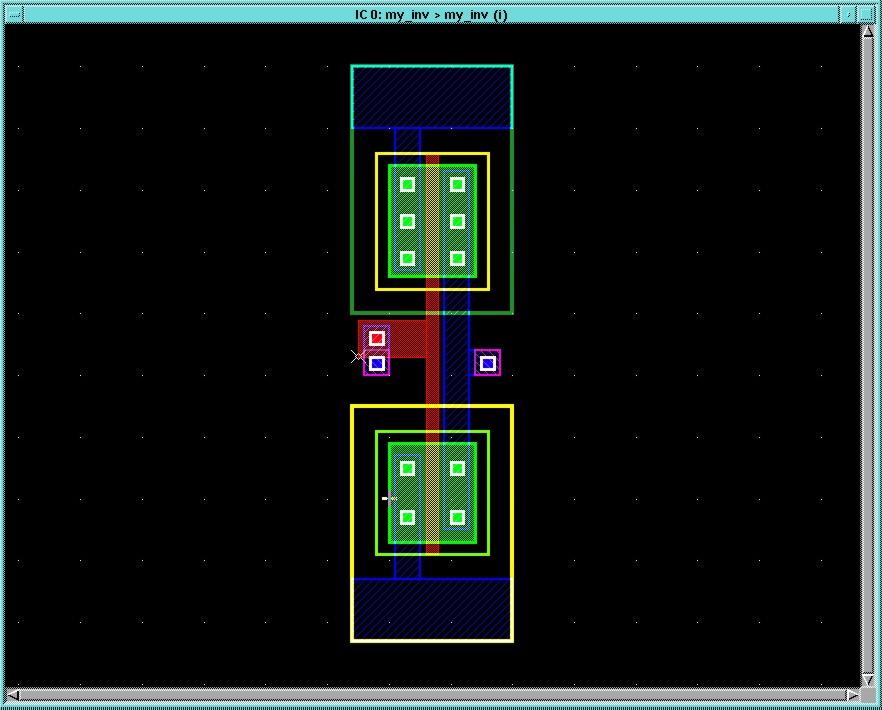
4. Create ports for place and route
As a cell is to be used in a much larger circuit, it needs to have
points where the connections can be made, i.e. input, output, VDD, GND.
4.1 From the pulldown menu, choose Other->Layers->Set
Selectable Layers. Choose METAL2 and then select the
left METAL2 box.
4.2 To make the port, use the pull-down menu, Objects->Make->Port.
In the prompt bar, enter (use tab key) in the dialog box enter the following:

Port Type = Signal; Direction = in; Port Name = in1, hit return.
4.3 Select the right METAL2, repeat the above step, enter the
following:
Port Type = Signal; Direction = Out; Port Name = out1, hit return.
Unselect all.
4.4 Repeat step one above but select METAL1, then select the
top METAL1, repeat step 2 above and enter the following in the prompt
bar.
Port Type = Power; Direction = In; Port Name = VDD, hit return.
4.5 Repeat step 4 but choose the bottom METAL1. Enter the following:
Port Type = Power; Direction = In; Port Name = GND, hit return.
Unselect all.
4.6 Make all the layers selectable by Other > Layers > Set Selectable
Layers and enter And/or type = all. Click OK.
5. Create metal blockages for place and route and floorplan shapes
When a cell is used in a bigger circuit and then routing occurs, only
the ports need to be visible, otherwise a short will take place. To accomplish
this we need to use blockages. A layer of METAL1.BLKG must be placed over
the entire device to keep metal 1 from being routed above it.
5.1 Add the following shapes at location -6,70 --> 20,-23. With Aspect
= Both, METAL1.BLKG and fp1.
5.2 To see what is visible to the outside world of this cell. View->Show->Aspect
with Aspect = External. You should see the inverter as below:
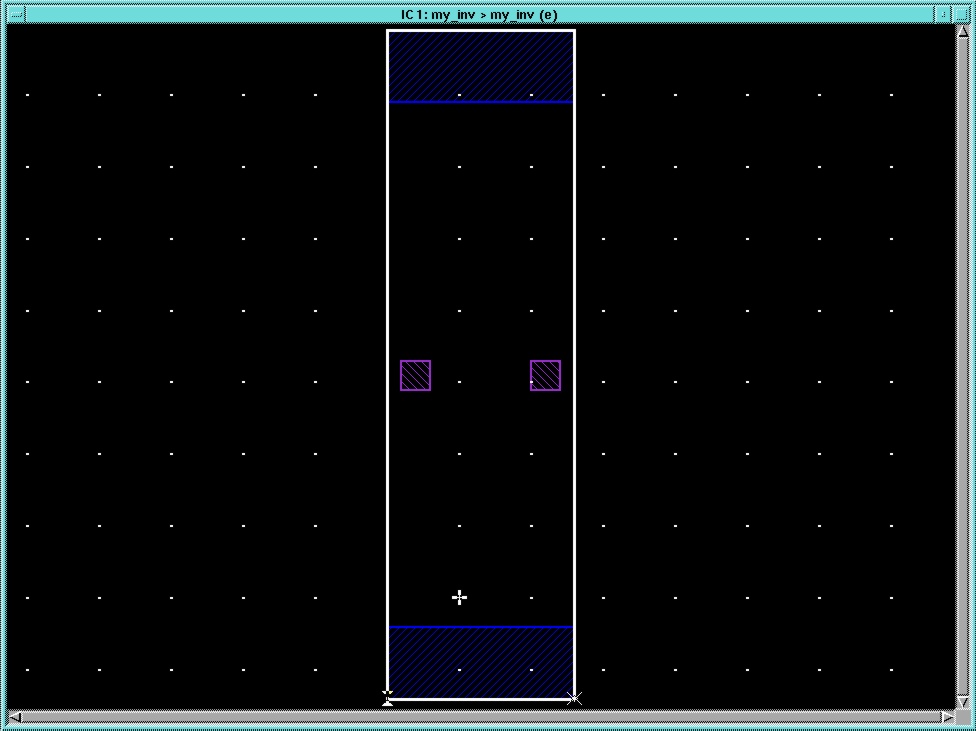
5.3 To see all the layers again, View->Show->Aspect,
Aspect= Both, click OK.
5.4 Save the cell using the File->Cell->Save
Cell menu item.
6. Perform a DRC check and fix the remaining errors
6.1 Click on BACK in the palette and choose IC Rules, then click
on Check. Under Rules File, click on OK.
6.2 You should get two errors. Go to Set Scan and click on
First
to see the first error. Then click on Next to see the next error.
You should the following two messages.
" [Current DRC] Result 1 of 1 in RuleCheck bad_nwell: Nwell must
have well contact (from: Ic/drc/drc_results_database 91)"
"[Current DRC] Result 1 of 1 in RuleCheck bad_psubstrate: Psubstrate
must have a substrate contact (from: Ic/drc/drc_results_database 91)"
These rules remind us that we need well contacts to avoid latchup problem.
See your text for more details. Create the following structures to eliminate
the errors.
(a) Create a 2x2 rectangle of CONTACT_TO_ACTIVE, a 6x6 ACTIVE
around it and a 10x10 rectangle of N_PLUS_SELECT. Place it in VDD.
Note, you may have to move it about a bit to find a place where it doesn't
violate any design rules.
(b) Create a similar structure but use P_PLUS_SELECT instead
of N_PLUS_SELECT and place it in GND. Make sure that DRC check
results in zero errors.
The layout of the inverter is now complete. The final product will look
like the figure below.
6.3 Save the cell and exit ICStation.
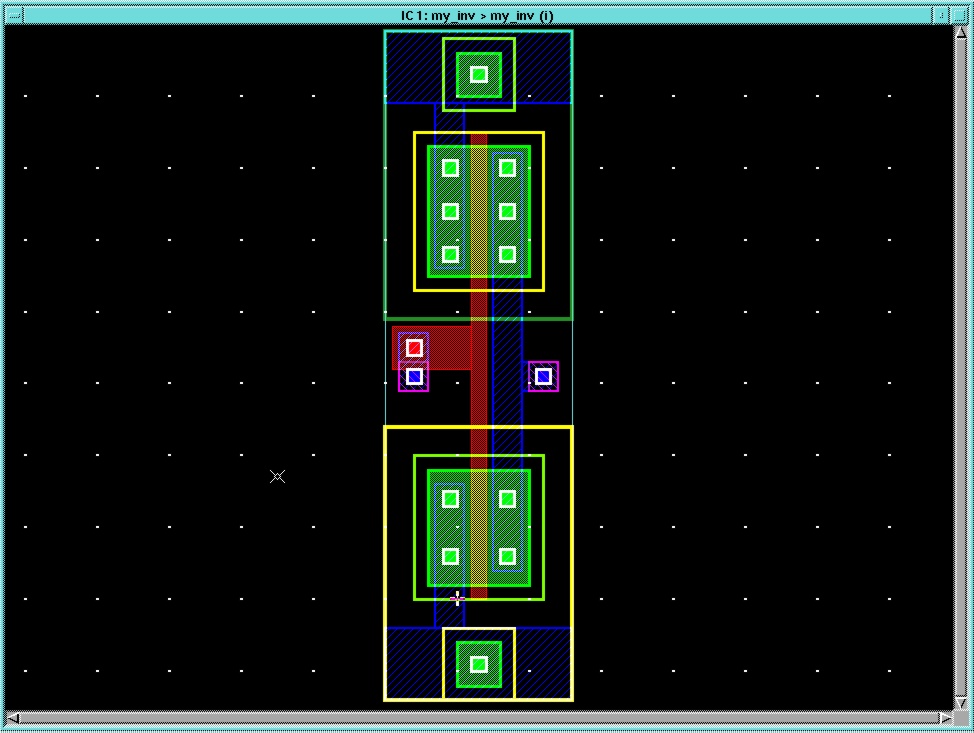
Acknowledgment - Based on the tutorial by:
M. Umar Farooq
Department of Electrical Engineering
West Virginia University Institute of Technology
Montgomery, WV 24315
and
Jack Meador
School of Electrical Engineering and Computer Science
Washington State University, Pullman WA 99164





